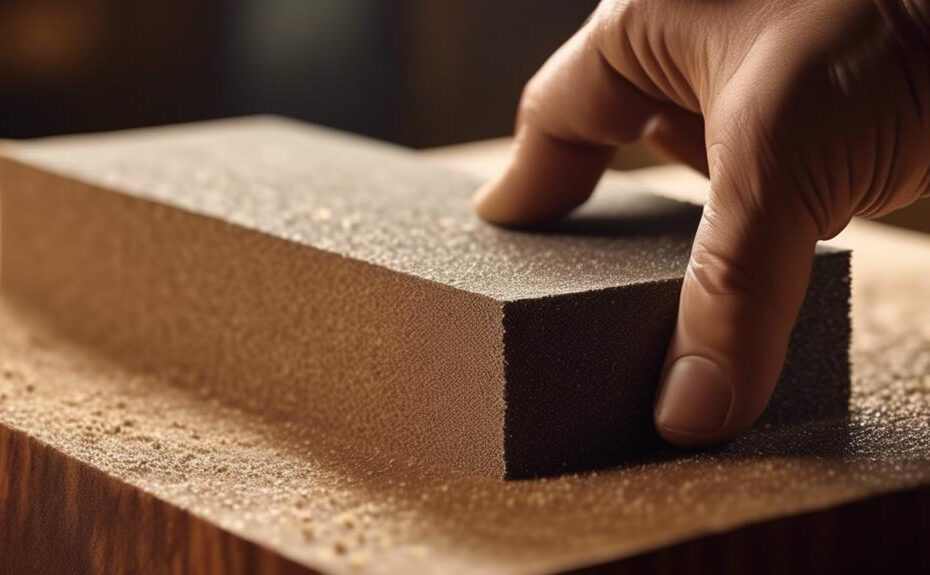Efficiency is key when it comes to wood surface preparation. High-performance sandpaper is the go-to choice for achieving a smooth and flawless finish. With its advanced composition and superior grit options, this sandpaper can significantly cut down on time and effort.
But what makes high-performance sandpaper so effective? And how do you choose the right grit for optimal results? In this discussion, we'll explore the types of high-performance sandpaper, its advantages, and provide tips for efficient wood surface preparation.
Key Takeaways
- High-performance sandpaper comes in different types, such as aluminum oxide, garnet, and silicon carbide, to cater to specific wood sanding needs.
- Using high-performance sandpaper can result in a superior finish, quicker cutting action, enhanced aesthetic appeal, and reduced sanding time and effort.
- Choosing the right grit is crucial for effective wood surface preparation, with coarse grits suitable for initial sanding and finer grits ideal for finishing.
- Proper usage of high-performance sandpaper includes selecting the appropriate grit, applying even pressure, sanding with the grain, and avoiding worn-out sandpaper or common mistakes like excessive pressure or neglecting to clean the surface.
Types of High-Performance Sandpaper
There are various types of high-performance sandpaper available for wood surface preparation. Different brands of high-performance sandpaper offer a range of options to suit specific applications.
One type is aluminum oxide sandpaper, which is commonly used for general wood sanding. It is durable and can effectively remove paint and varnish.
Another type is garnet sandpaper, which is ideal for fine finishing work. It produces a smooth surface and is often used for sanding bare wood.
Silicon carbide sandpaper is another option, known for its aggressive cutting action. It is commonly used for sanding hard materials like metal and plastic.
These different types of high-performance sandpaper cater to the diverse needs of woodworkers and provide efficient solutions for various wood surface preparation applications.
Advantages of Using High-Performance Sandpaper
High-performance sandpaper offers several advantages for wood surface preparation. One of the key benefits of using high-quality sanding tools is the superior finish they provide. High-performance sandpaper is designed to cut through wood quickly and efficiently, resulting in a smooth and even surface. This not only enhances the aesthetic appeal of the final product but also improves the overall quality and durability of the woodwork.
Additionally, high-performance sandpaper reduces the time and effort required for sanding, leading to increased project efficiency. With its ability to remove material effectively, it minimizes the need for multiple sanding passes, saving both time and energy.
Choosing the Right Grit for Efficient Wood Surface Preparation

To achieve efficient wood surface preparation, selecting the appropriate grit is essential. The grit refers to the coarseness or fineness of the sandpaper, and it determines the level of abrasiveness. Using the wrong grit can lead to ineffective sanding and even damage to the wood surface.
To help you choose the right grit for your wood surface, here is a table that outlines the recommended grits for different stages of wood preparation:
| Stage of Wood Preparation | Recommended Grit |
|---|---|
| Coarse Sanding | 40 – 60 |
| Medium Sanding | 80 – 120 |
| Fine Sanding | 150 – 180 |
| Extra Fine Sanding | 220 – 320 |
| Sanding Between Coats | 400 – 600 |
It is important to note that proper sanding technique is equally important. Some common mistakes to avoid when sanding wood surfaces include using too much pressure, neglecting to clean the surface before sanding, and not sanding with the grain of the wood. By selecting the right grit and employing proper sanding techniques, you can achieve efficient and high-quality wood surface preparation.
Tips for Properly Using High-Performance Sandpaper
Properly utilizing high-performance sandpaper is crucial for achieving efficient wood surface preparation and avoiding damage to the wood. To help you achieve the best results, here are some tips for properly using high-performance sandpaper:
- Choose the right grit: Select the appropriate grit based on the type of wood and the level of sanding required. Coarser grits are suitable for initial sanding, while finer grits are ideal for finishing.
- Use proper sanding techniques: Apply even pressure and sand with the grain of the wood to prevent scratches and achieve a smooth surface. Move the sandpaper in a back-and-forth or circular motion for consistent results.
- Avoid common mistakes: Do not press too hard, as it can cause uneven sanding and damage the wood. Additionally, avoid using worn-out sandpaper, as it can leave visible marks and compromise the quality of the finish.
Frequently Asked Questions
How Long Does High-Performance Sandpaper Typically Last Before It Needs to Be Replaced?
The longevity of high-performance sandpaper depends on various factors such as the type of material being sanded and the intensity of use. Signs that indicate the need for replacement include worn-out grit, reduced effectiveness, and visible damage.
Can High-Performance Sandpaper Be Used on Other Materials Besides Wood?
High-performance sandpaper has versatile applications in metalworking, making it suitable for use on materials besides wood. Comparing its effectiveness on different materials can provide valuable insights for optimizing surface preparation in various industries.
Are There Any Safety Precautions That Need to Be Taken When Using High-Performance Sandpaper?
When using high-performance sandpaper, it is crucial to adhere to safety precautions to prevent injuries. This includes wearing protective gear such as goggles and gloves, working in a well-ventilated area, and properly disposing of used sandpaper to avoid environmental harm.
Can High-Performance Sandpaper Be Used for Both Rough Sanding and Fine Finishing?
Yes, high-performance sandpaper can be used for both rough sanding and fine finishing. It is designed to efficiently remove material during rough sanding while also providing a smooth and polished surface for delicate finishes.
Is It Necessary to Use a Specific Type of Sanding Tool With High-Performance Sandpaper?
Using a specific sanding tool with high-performance sandpaper is not necessary, but it can enhance the efficiency and results. Different types of sanding tools offer distinct advantages when paired with high-performance sandpaper, such as better control, faster material removal, and smoother finishes.
Conclusion
In conclusion, high-performance sandpaper offers numerous advantages for efficient wood surface preparation. By choosing the right grit and using proper techniques, woodworkers can achieve smooth and polished surfaces with ease.
One interesting statistic to consider is that using high-performance sandpaper can increase productivity by up to 50%, resulting in significant time and cost savings.
This imagery highlights the effectiveness and efficiency of using high-quality sandpaper in woodworking projects.




